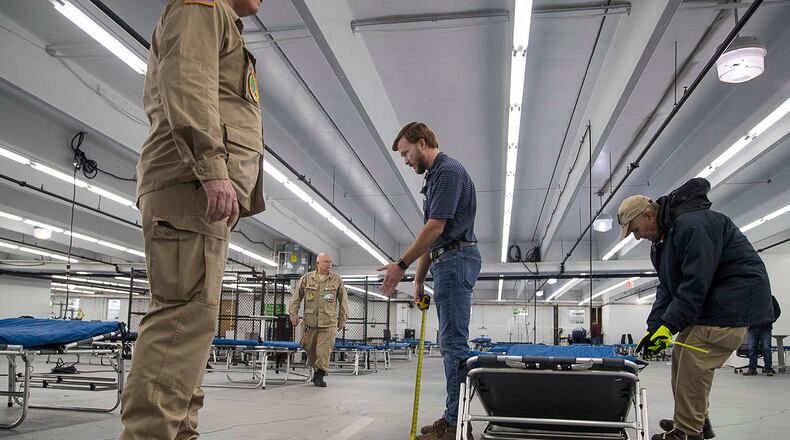First it hit Albany, and hundreds were infected within a few weeks. Then after it took hold in Dougherty County, it spread to Randolph, Mitchell, Carroll and Early counties.
With the coronavirus threatening Colquitt, Robin Rau, CEO of Miller County Hospital Authority, barred visitors and required employees to pass health screenings before they could enter. Infected patients were treated in isolation rooms staffed by nurses who didn’t work elsewhere in the 25-bed hospital.
» COMPLETE COVERAGE: Coronavirus in Georgia
» THE LATEST: How Georgia hospitals are dealing with coronavirus
Now, when other facilities overwhelmed with COVID-19 cases ask if she can help relieve the burden, she tells them the tiny hospital can’t take on more people infected with the virus. It doesn’t have the staff to isolate and care for additional patients and also fears that the virus could spread to the hospital’s adjacent nursing home.
“By whatever means necessary,” she said, “we had to prevent this virus from getting into this facility.”
When Gov. Brian Kemp this past week decided to start reopening parts of the state for business, he said that Georgia had already hit its peak of cases and hospitals now have increased capacity to handle critically ill patients. Those were among guidelines that President Donald Trump gave governors for gradually restarting their economies.
But some areas of the state remain swamped with cases while others have yet to hit their projected peak, and there are significant disparities across Georgia in the resources that hospitals have available to care for COVID-19 patients.
Many large hospital networks have launched aggressive programs to expand ICU capacity and add isolation rooms, and some have banded together to strategize and distribute resources. There are worries, though, that as businesses reopen, they may compete for needed supplies and hospitals could be hit with a second wave of cases.
Other hospitals, particularly those in rural areas and small towns where cases continue to surge, say they don’t have enough staff or beds as it is. LifeBrite Community Hospital of Early and Southwest Regional Medical Center in Cuthbert — two hard-hit areas of the state — urgently need more nurses and proper personal protective equipment, said state Rep. Gerald Greene, R-Cuthbert. The worst-off hospitals warn that unless they can immediately get more resources, residents will needlessly die.
“Georgia needs to step up to the plate,” said Greene, who has watched hospitals in his nine-county constituency fall like dominoes to COVID-19. “Our hospitals have been pushed to the brink.”
The need for doctors, nurses, supplies and equipment has become so intense in some parts of the state that officials have been forced into hard decisions.
Southwest Regional has diverted inpatient admissions and ambulance traffic because of staffing and turned to Phoebe Putney Health System in Albany for help. The Southwest medical complex includes Joe-Anne Burgin Nursing Home, which has 54 infected residents and 24 infected staff. Overall, Randolph County, population 7,000, has had 149 cases and 18 deaths as of 1 p.m. Thursday.
LifeBrite in Blakely asks residents to avoid the emergency room unless they are gravely ill. The hospital is currently out of isolation gowns, and so at the end of each day the remaining gowns are laid in a room and disinfected with a Curis fogger.
Administrator Ginger Cushing said some suppliers want as much as $40,000 for a new stock of gowns, which the hospital can’t afford. She just ordered 1,000 lab coats for $1,200 through a connection in Mississippi and has been looking into buying painting coveralls from Sherwin-Williams or Home Depot.
“Every day it’s a search to see what we can get and what we can afford,” Cushing said. “Everybody I’ve talked to is like, ‘Let me know what you need.’ But then it’s just so hard to get what we need that you really have to have the hospital contact people and tell them how desperate you are.”
Early County, which has about 10,000 residents, has 186 coronavirus cases and 15 people have died as of Thursday afternoon. Ten of the dead were residents of a nursing home that is part of LifeBrite hospital, and ten nursing home employees have been infected.
In Miller County, which had no coronavirus deaths as of Thursday, Rau said she made the decision not to accept coronavirus patients from other facilities to avert a disaster. At the hospital’s adjacent skilled nursing facility are dozens of fragile patients on ventilators for non-COVID health conditions. She couldn’t risk having the disease spread there.
That’s why two weeks ago, she reversed a decision to take 11 nursing home patients from a facility riddled with COVID-19 cases. The home said none of the 11 were infected, so Rau was going to move them to the Miller County nursing home. But when they arrived, she had them put into quarantine to be re-tested. Many were infected, so she returned them.
» RELATED: Kemp opens some businesses, despite warning that COVID-19 still a threat
» MORE: Coronavirus pandemic hits Southwest Georgia county hard
“We’re not going to infect anybody else,” she said. “Otherwise, we would have accomplished nothing.”
In areas of South Georgia, hospitals are still bracing for a surge.
At Tift Regional Medical Center in Tifton, surgeon Joel Johnson is getting ready to do work he hasn’t done in a decade, reading up on how to run a modern ventilator and planning to keep a printout in his pocket when he’s called up. His hospital’s numbers are inching up to more than 200 cases, and it has seen a couple deaths per day.
The cases have strained the hospital, the physician said. “Those that are hospitalized are very ill and require large resources of personnel and equipment…,” he said. “The intensity of services and mental fatigue required by the personnel of our ICU has been without comparison. It has affected us all.”
The peak has also yet to hit Metter, an hour outside of Savannah. To prepare for it, Candler County Hospital CEO Michael Purvis converted a storage house into a triage facility, because he couldn’t afford to rent a mobile tent for $10,000 a month. He says his 25-bed rural hospital can easily be overwhelmed by even a few patients and is frustrated that he lacks resources to save lives.
“Not being able to save these folks,” Purvis said, “I can just imagine seeing hundreds of people die before you, and we don’t have good medicine to stop it or reverse it.”
Standing ready
After weeks of efforts to expand capacity, many health systems in metro Atlanta and Georgia’s other populous areas say they now do have more capacity to care for patients.
In Atlanta, Kemp announced earlier this month that the state was establishing a makeshift hospital at the Georgia World Congress Center with 200 beds for patients with mild to moderate COVID-19 symptoms. In an emergency scenario, that facility can be adjusted to accommodate 400, he said.
Piedmont Atlanta Hospital opened the Marcus Tower on April 13, nearly four months early, providing 132 additional beds, including 64 ICU beds. Piedmont also said that Piedmont Columbus Regional, through a donation from the family of Aflac chairman Dan Amos, renovated a previously unoccupied floor in Doctors Hospital on its campus, adding 36 beds.
The state’s major hospital networks also say that they can maximize resources by transferring patients among their facilities.
Some hospitals are not certain, though, that they can cope in worst-case scenarios.
Northeast Georgia Health System has been preparing since January to handle a surge of infected patients. ICU capacity at the four hospitals in the system has increased 40% since then, and medical/surgical beds have increased 10%. In addition, the state has provided mobile units outside emergency rooms at the system’s Gainesville and Braselton hospitals, and on May 5, another GEMA mobile unit with 20 beds is expected to arrive, officials said.
As of Monday, the system was treating 111 patients and had another 79 awaiting test results, its website showed. Fifteen have died.
"Georgia needs to step up to the plate. Our hospitals have been pushed to the brink." —State Rep. Gerald Greene, R-Cuthbert
But the regional peak hasn’t yet hit the area, and the system is warning that its hospitals can be overwhelmed if people don’t continue to follow recommendations by physicians and clinical experts to stay home as much as possible.
Navicent Health in Macon’s own modeling shows the area won’t hit its peak for coronavirus infections until early May, said Julie Windom, the hospital’s government relations liaison.
The state is providing a mobile unit which will add 24 beds for regular patients, freeing up other beds in the hospital for those infected with COVID-19, and the hospital now has ample staffing, medication and equipment for the expected surge.
Windom said she is concerned, though, that the hospital may find it hard to secure some supplies as local businesses start reopening in the coming weeks.
“We’re hearing businesses say they’re going to give masks out to their customers and to their employees,” Windom said. “That’s good practices, but it may cause a strain on the supply of those items.”
At Floyd Medical Center in Rome, before any coronavirus cases were confirmed in northwest Georgia, CEO Kurt Stuenkel struck a deal to turn a closing hospital facility next door into an overflow wing, planning for coronavirus patients. After a patient tested positive March 6, he, a clinic and another nearby hospital, as well as a local director with the state Department of Public Health, asked local elected officials to close bars, gyms and in-person dining. The county and city took that vote March 19, before the state limited large gatherings, and two weeks before Kemp's order shutting down such businesses statewide. As of 1 p.m. Thursday, the county has had 128 confirmed cases and eight deaths.
Stuenkel said he asked the state for its latest projection on when the peak would hit northwest Georgia, but was told the state didn’t have that because it was focusing on other areas. As of Thursday the hospital’s in-house modeling projects its peak will hit May 6. Stuenkel said the hospital is in good shape with PPE, thanks in part to staff sourcing it from across the globe and also to reusing both N95 and regular surgical masks until they become “noticeably damp.”
When asked what he thought of the governor’s announcement Tuesday to start reopening businesses, Stuenkel paused more than 10 seconds before answering. “It’s hard to say, really,” he finally said. “I mean we’re all concerned about the progression of the disease, and if the models are correct. And we’re also very concerned about the health of the economy.” He also noted that unemployment can have serious consequences for mental health such as an increase in suicides.
“I really appreciate how difficult this decision is,” he said.
Unsure of what may happen, Stuenkel said that even though the state provided a pop-up hospital, he is still going to finish building one he had started in the hospital’s garage. Just in case.
Cushing, the Early County hospital administrator, said based on her patient numbers, she would rather wait another month to start reopening businesses.
“I just think there’s going to be more infection and transmission of the virus, and people gathering again and just congregating and ignoring all the rules,” she said. “I’m afraid that people are just going to hear, ‘Oh, we’re opening back up,’ and try to get back to normal. And we don’t need to.”
Keep Reading
The Latest
Featured











